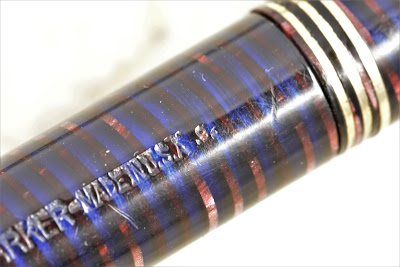This article has been edited and included in The Leadhead's Pencil Blog Volume 5; copies are available print on demand through Amazon here, and I offer an ebook version in pdf format at the Legendary Lead Company here.
If you don't want the book but you enjoy this article, please consider supporting the Blog project here.
But 1939 was different for everyone, Parker included. America was still in the Depression, and the late Thirties in general represented a time when pen manufacturers great and small alike were pulling out all the stops to introduce gimmicks to attract the largest share possible of a much smaller pool of customers.
In Parker’s case, the answer was the Parker 51, which had just come out of research and was about to take the pen world by storm. But there was a problem . . . the company’s flagship Vacumatic line was still in production, and apparently Parker had quite a bit of leftover stock of what would soon become an obsolete commodity. Perhaps in anticipation of the 51s success, and with an uncharacteristic “waste not, want not” approach, Parker took some unusual steps to use up what was on hand rather than put it in a dumpster.
One example of this was the “Ripley” Vacumatic, about which I’ve written here a few times (see Volume 2, page 212 and Volume 4, page 48). Nicknamed after the mock “Ripley’s Believe it or Not” cartoons used to promote the new Vacumatic when it was introduced in 1933, they are relatively easy to spot with their early trim configurations and wider-than-usual alternating stripes, but the acid test for whether an early Vac is a Ripley is to hold it up to the light and see if the dark strips glow blue.
At the Chicago Show, I had the opportunity to buy another Ripley and, partly because these came up so rarely, I didn’t mind a significant investment to add another to the fold:
I say “partly” because the bulk of my motivation was that the new example, the lower one in this picture, needs no light to confirm its Ripleyness. It simply glows blue as if there were already a light inside it!
There was another reason for the purchase, though . . . this one has something you won’t find on a “normal” Ripley:
That 9 with two dots at the end of the imprint is a date code signifying production in 1939, long after the Ripley advertising campaign had ended. Several Vacumatic aficionados, most notably Brian McQueen, have noted this anomaly, and several examples bearing a 1939 date code have turned up with advertising imprints, another thing you don’t see on the earlier incarnation of the Ripley. Given the 1933-period correct trim and mechanism, abandoned after Parker outsourced production of its pencil mechanisms to Cross, the only plausible explanation for these is that Parker had stores of complete, assembled Ripley pencils somewhere in its warehouse that the company decided to sell rather than scrap.
Parker also used up leftover rod stock. This one also came from Chicago, although I can’t remember who from:
This example is odd not only because of the lack of center trim bands (no, there’s no grooves where they have gone missing), but in the placement of the middle joint: the lower barrel is significantly longer than usual, with the break between the cap and lower barrel just a quarter inch or so below the end of the clip. Also, even though this is a slender pencil that would usually have a black jewel on top, this one has a diminuative striped jewel, one of the smallest I’ve seen:
I consulted with a few Parker guys who confirmed this is a legitimate weird variant, which makes sense given the imprint, which confirms this one is also a graduate of the class of ‘39:
This last one I’ve been wanting to show you for awhile – it belongs to Joe Nemecek, and I photographed it at the Baltimore show when my skills with a camera were far more feeble:
This one lacks a date code, because it was a lower-priced line at the time: the Parker Televisor:
The Televisor was a Parker model made exclusively in and for the Canadian market. According to Tony Fischer’s website, it was introduced in 1935 and came in two incarnations: the first, which he calls “MKI,” looks a lot like a Parker Challenger, but in 1938, he says the line was redesigned to include a clip with “Parker” on it, like this one. The line was discontinued in 1940.
Tony doesn’t show any picture with this 1938-and-later clip, but I suspect Joe’s example is a prime example:
Instead of a straight clip, Joe’s example has a “waterfall” shape to it, and note that where the clip is sandwiched between the cap and that top button, the clip bulges out a bit from the plastic. Was this a repurposed clip, bent out to fit a pencil with a wider girth? I don’t think so. By that time, Tony indicates you could have any color so long as it was black, and looks more like a last-ditch effort to add a bit of pizzazz to a dying line.









No comments:
Post a Comment